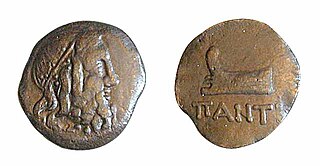
The Bosporan Kingdom, also known as the Kingdom of the Cimmerian Bosporus, was an ancient Greco-Scythian state located in eastern Crimea and the Taman Peninsula on the shores of the Cimmerian Bosporus, centered in the present-day Strait of Kerch. It was the first truly 'Hellenistic' state, in the sense that a mixed population adopted the Greek language and civilization, under aristocratic consolidated leadership. Under the Spartocid dynasty, the aristocracy of the kingdom adopted a double nature of presenting themselves as archons to Greek subjects and as kings to barbarians, which some historians consider unique in ancient history. The Bosporan Kingdom became the longest surviving Roman client kingdom. The 1st and 2nd centuries AD saw a period of a new golden age of the Bosporan state. It was briefly incorporated as part of the Roman province of Moesia Inferior from AD 63 to 68 under Emperor Nero, before being restored as a Roman client kingdom. At the end of the 2nd century AD, King Sauromates II inflicted a critical defeat on the Scythians and included all the territories of the Crimean Peninsula in the structure of his state.
The Spartocids or Spartocidae was the name of a Hellenized Thracian dynasty that ruled the Hellenistic Kingdom of Bosporus between the years 438–108 BC. They had usurped the former dynasty, the Archaeanactids, who were tyrants of Panticapaeum from 480 to 438 BC. The throne of the Bosporan Kingdom was usurped by Spartokos I in 438 BC, after whom the dynasty is named.
Satyrus I was the Spartocid ruler of the Bosporan Kingdom from 432 BC to 389 BC. During his rule he built upon the expansive foreign policy of his father, Spartocus I. He conquered Nymphaion, became involved in the political developments of the neighbouring Sindike kingdom and laid siege to the city of Theodosia, which was a serious commercial rival because of its ice-free port and proximity to the grain fields of eastern Crimea.

Leucon II of Bosporus, also known as Leuco, seems to have been the second son of Paerisades II and a Spartocid ruler of the Bosporan Kingdom in 240 BC.
Gorgippus was a son of Satyrus I and was a Spartocid joint ruler with his brother Leucon of the Bosporan Kingdom. He situated himself on the Asiatic side of the kingdom, in Gorgippia where he ruled until, presumably, his death in 349 BCE.
Eumelus of Bosporus was a Spartocid ruler of the Bosporan Kingdom and a son of Paerisades. Eumelus was the brother of Satyrus II and Prytanis.
The siege of Theodosia was a siege carried out by Leukon I sometime after his accession to the Bosporan throne in around 365 BC. Satyrus I, the father of Leukon, had previously laid siege on Theodosia but died during it. The exact numbers of the forces in the siege aren't known.

The Bosporan Kingdom waged a series of wars of expansion in the Cimmerian Bosporus and the surrounding territories from around 438 BC until about 355 BC. Bosporan expansion began after Spartokos I, the first Spartocid took power and during his seven-year reign, established an aggressive expansionist foreign policy that was followed by his successors.
The siege of Theodosia in c. 360 BC was the third and final siege by the Bosporan Kingdom under Leukon I against the city of Theodosia, a probable colony of Heraclea Pontica, who had aided the city in two previous sieges.
Paerisades I also known as Birisades, Pairisades, and Parysades was a Spartocid king of the Bosporan Kingdom from 342 to 310/9 BC.
Satyrus II was a son of Paerisades I and Spartocid king of the Bosporan Kingdom for 9 months in 310 BC. He was the elder brother of Eumelus and Prytanis. He was challenged and ultimately overthrown by Eumelus in the Bosporan Civil War.

Paerisades IV Philometor seems to have been a Spartocid king of the Bosporan Kingdom from c. 150 to 125 BC.
Paerisades III was a son of Leukon II and Alkathoe, he also succeeded his brother Spartokos V as Spartocid king of the Bosporan Kingdom from 180 to 150 BC. He co-ruled with Kamasarye II.
Spartocus III was king of the Bosporan Kingdom from 304 to 284 BC. He succeeded to the throne after the death of his father Eumelus in a carriage accident.
Camasarye II Philoctenus or Comosarye was a daughter of Spartocus V and a Spartocid queen of the Bosporan Kingdom from 180-160/150 BC. She was the wife of her cousin Paerisades III and a granddaughter of Leucon II. She co-ruled with Paerisades III.
The Battle of Labrytae was a battle around 380 BC that occurred nearly directly after Octamasades usurped the Sindian throne from his father Hecataeus and attacked and took the city of Labrytae, presumably a city under Bosporan rule. Leukon, the ruler of the Bosporan Kingdom, had made war upon Oktamasades on behalf of Hekataios, who was a vassal of the Bosporans prior to his removal from the throne.
Sopaios or Sopaeus or Sinopeus was a powerful Bosporan minister to Satyros I, the father of queen Theodosia, and father-in-law to Leukon I.
The Bosporan–Heracleote War was a long and enduring conflict between the states of Heraclea Pontica and the Bosporan Kingdom. It lasted decades, but ended after the Bosporans finally conquered the city-state of Theodosia in around 360 BCE.
The Bosporan–Sindian War was a war between the Sindike Kingdom and its allied tribes against the Bosporan Kingdom in the 4th century BC. The war took place amidst the wars of expansion and took the life of the brother of Leukon and Gorgippos, Metrodoros.
Spartocus I was the founder and first ruler of the Spartocid dynasty in the Bosporan Kingdom. He usurped the former rulers of the Bosporus, the Archaeanactids, after being a mercenary under their command sometime in 438 BC.



